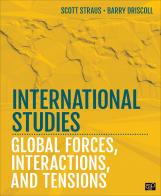International Studies: Global Forces, Interactions, and Tensions
Welcome to the SAGE edge site for International Studies: Global Forces, Interactions, and Tensions.
The SAGE edge site for International Studies: Global Forces, Interactions, and Tensions by Scott Straus and Barry Driscoll offers a robust online environment you can access anytime, anywhere, and features an impressive array of free tools and resources to keep you on the cutting edge of your learning experience.

The challenge of teaching international studies is to help students think coherently about the multiple causes and effects of global problems. In International Studies: Global Forces, Interactions, and Tensions, award-winning scholars Scott Straus and Barry Driscoll give students a clear framework that pinpoints how key factors—forces, interactions, and tensions—contribute to world events, with both global and local consequences.
The authors first show students how to look for common patterns in global issues by introducing four world-shaping forces: global markets, shifting centers of power, information and communications technologies, and global governance. They systematically trace how these forces prompt interactions among world actors and thus give rise to a set of tensions that spur key challenges. The framework enables students to ask and answer for themselves—Who is interacting? Where did such interactions develop? What policies or institutions govern them? Why are they getting certain global and local reactions?
Students then apply the framework to the global problems that matter most to them: human rights abuses, economic inequality, terrorism, forced migration, pandemics and global health responses, climate change, food security, and more. International Studies raises the bar for the Introduction to IS course, moving beyond interdisciplinary, and into the realm of critical analysis to increase student relevancy and motivation.
Acknowledgements
We gratefully acknowledge Scott Straus and Barry Driscoll for writing an excellent text. Special thanks are also due to Rachel Schwartz of the University of Wisconsin–Madison and Carolyn Morgan for developing the ancillaries on this site.

